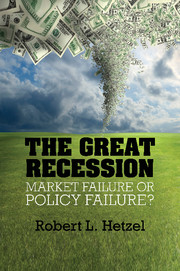Book contents
- Frontmatter
- Contents
- Figures
- Tables
- Preface
- One The 2008–2009 Recession
- Two Recessions
- Three The Great Contraction
- Four Monetary Policy and Bank Runs in the Great Depression
- Five Vigorous Recovery and Relapse
- Six Interwar International Monetary Experiments
- Seven Identifying the Shocks that Cause Recessions
- Eight From Stop-Go to the Great Moderation
- Nine Controlling Bank Risk Taking
- Ten The Housing Crash
- Eleven Bubble Trouble
- Twelve What Caused the Great Recession of 2008–2009?
- Thirteen What Caused the Great Leverage Collapse?
- Fourteen The Distinctions Between Credit, Monetary, and Liquidity Policy
- Fifteen Fed Market Interventions
- Sixteen Evaluating Policy
- Seventeen The Business Cycle
- Eighteen Why Is Learning So Hard?
- Nineteen How Should Society Regulate Capitalism?
- Postscript
- Bibliography
- Index
Three - The Great Contraction
1929–1933
Published online by Cambridge University Press: 05 May 2012
- Frontmatter
- Contents
- Figures
- Tables
- Preface
- One The 2008–2009 Recession
- Two Recessions
- Three The Great Contraction
- Four Monetary Policy and Bank Runs in the Great Depression
- Five Vigorous Recovery and Relapse
- Six Interwar International Monetary Experiments
- Seven Identifying the Shocks that Cause Recessions
- Eight From Stop-Go to the Great Moderation
- Nine Controlling Bank Risk Taking
- Ten The Housing Crash
- Eleven Bubble Trouble
- Twelve What Caused the Great Recession of 2008–2009?
- Thirteen What Caused the Great Leverage Collapse?
- Fourteen The Distinctions Between Credit, Monetary, and Liquidity Policy
- Fifteen Fed Market Interventions
- Sixteen Evaluating Policy
- Seventeen The Business Cycle
- Eighteen Why Is Learning So Hard?
- Nineteen How Should Society Regulate Capitalism?
- Postscript
- Bibliography
- Index
Summary
The Great Depression remains the most horrific economic event in the twentieth century. In the 1948 edition of Economics: An Introductory Analysis, Paul Samuelson wrote, “It is not too much to say that the widespread creation of dictatorships and the resulting World War II stemmed in no small measure from the failure to meet this basic economic problem [the Great Depression] adequately” (cited in University of Chicago 2009). The Depression gave birth to modern macroeconomics. Sorting out the causes of the Depression remains essential to achieving professional agreement within monetary economics about the appropriate model of the economy to use for the design of stabilization policy in general and monetary policy in particular.
This chapter complements Hetzel (2008b, ch. 3) by using historical narrative to distinguish between the market-disorder (credit-cycle) and monetary-disorder views of the cause of the Depression. Strong similarities exist in the way that policy makers in the Depression and policy makers in the 2008–2009 recession understood the causes of cyclical downturns. A cyclical downturn begins with the bursting of a speculative asset bubble and propagates through the dysfunction in financial markets produced by the forced liquidation of the excessive debt acquired in the prior boom. The issue then arises of how the Great Depression and the 2008–2009 recession could have been so intense if policy makers had the correct understanding of the business cycle as a manifestation of financial market dysfunction as opposed to monetary disorder.
- Type
- Chapter
- Information
- The Great RecessionMarket Failure or Policy Failure?, pp. 23 - 45Publisher: Cambridge University PressPrint publication year: 2012

